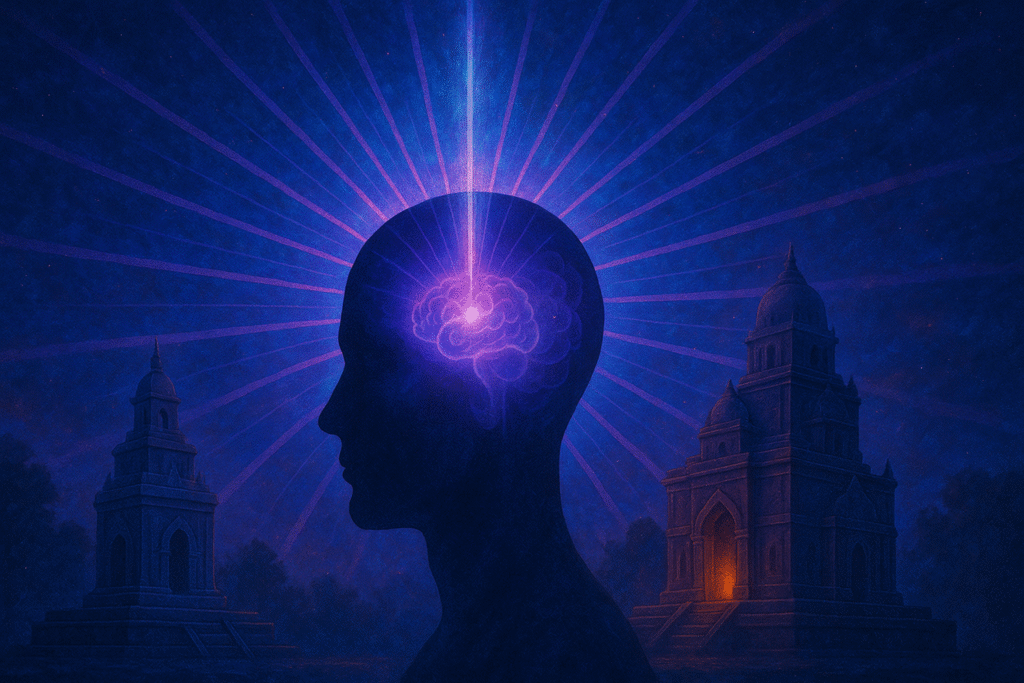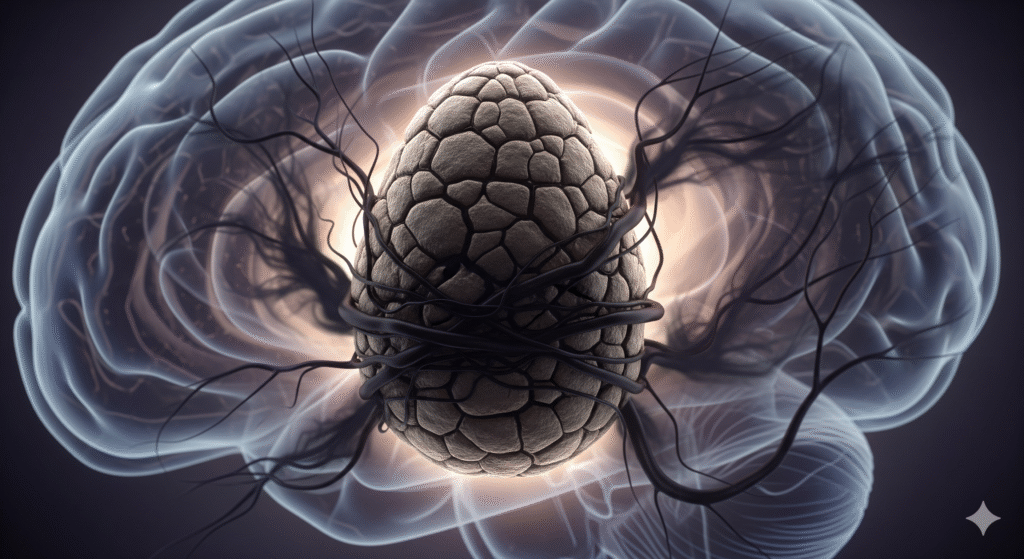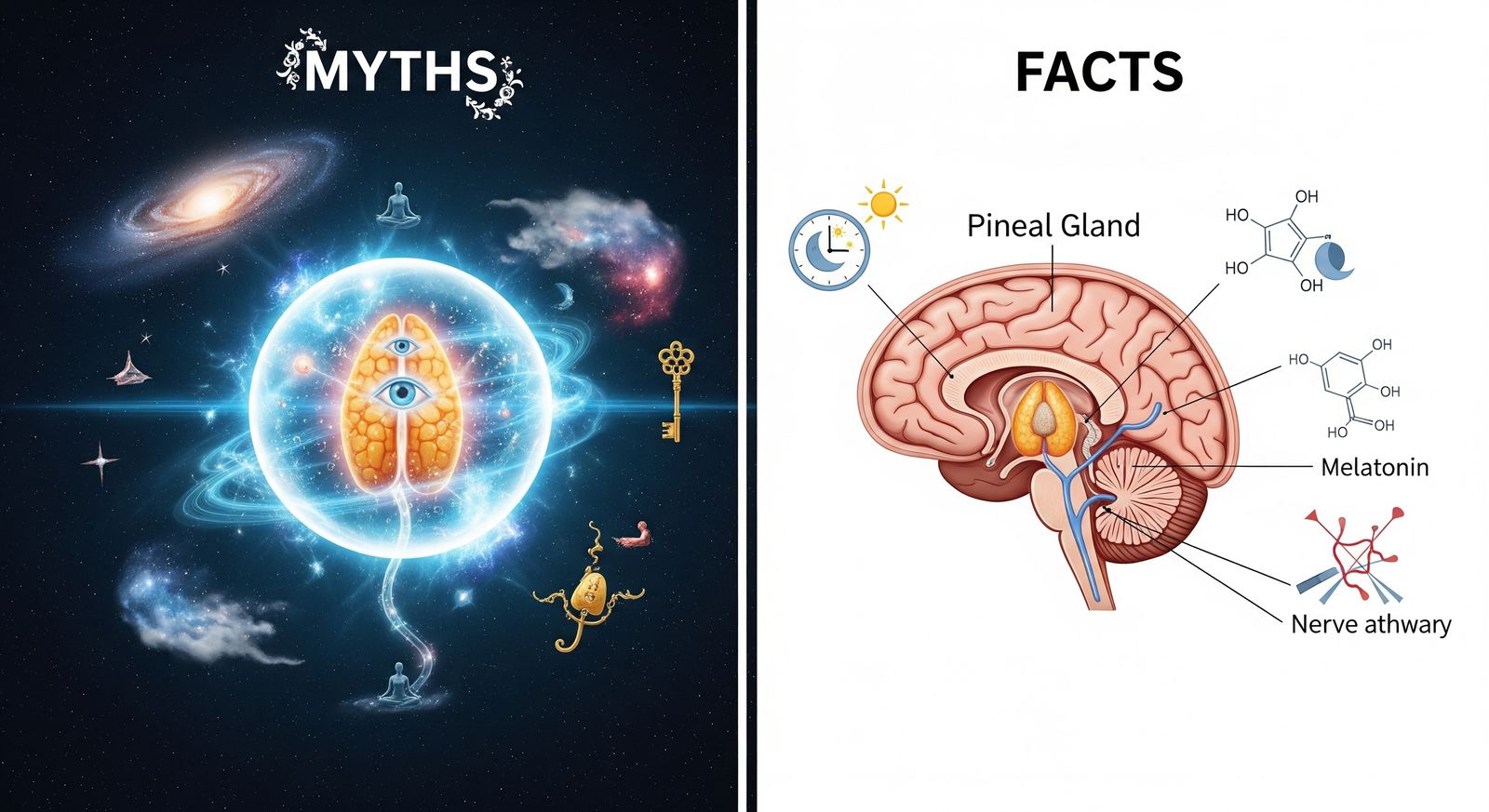Have you ever heard people talk about the “third eye” and wondered what it really means? For thousands of years, different cultures have believed that humans have a hidden doorway to higher wisdom and inner peace. This doorway is linked to a small, pea-sized organ deep inside your brain-the pineal gland.

The pineal gland has fascinated philosophers, scientists, and spiritual seekers alike. Some call it the “seat of the soul.” Others see it as a key to spiritual awakening.
In science, the pineal gland is known for producing melatonin, a hormone that regulates your sleep and circadian rhythm. But beyond that, many believe it can unlock extraordinary clarity, awareness, and even deep spiritual experiences.
In this detailed guide, we will explore how to activate pineal gland step by step. We will talk about detoxification, foods, supplements, meditation, light exposure, and practices that can gradually awaken this tiny but powerful gland.
What Is the Pineal Gland?
The pineal gland is located right in the center of your brain, between the two hemispheres. It is shaped like a small pinecone (that’s why it is called “pineal”). Even though it is tiny, its functions are powerful.
- Biological Role: The pineal gland produces melatonin, a hormone that controls your sleep-wake cycle. This is why it is sometimes called the “body’s clock regulator.”
- Spiritual Role: Many ancient traditions, from Egypt to India, considered it the center of intuition, wisdom, and enlightenment. In Hinduism, it is connected to the Ajna chakra (third eye). In Egyptian culture, the Eye of Horus resembles the pineal gland, showing how deeply it was respected as a spiritual symbol.
When people search for pineal gland spiritual meaning, they often discover that it is considered the gateway to higher consciousness.
This is why learning how to activate pineal gland has become so popular among both spiritual seekers and health-conscious people.
Why Activate the Pineal Gland?
You may wonder: why should anyone try to activate it? Isn’t it already working in the body?
The truth is, in many people today, the pineal gland is sluggish or even calcified. Modern lifestyle, diet, and exposure to toxins block its natural function. When the pineal gland is not active, you may face:
- Poor sleep quality
- Mood swings
- Lack of focus
- Low motivation
- Feeling disconnected from yourself
On the other hand, when you learn how to activate pineal gland, you can experience life-changing benefits:
- Better Sleep and Energy – Because melatonin production improves.
- Mental Clarity – Clearer thinking and stronger decision-making.
- Inner Peace – Reduced anxiety and emotional balance.
- Spiritual Awareness – Deeper meditation, intuition, and connection with your higher self.
Want to dive deeper into these benefits? Discover what happens when the pineal gland is activated.
In fact, research shows that melatonin not only helps with sleep but also supports the immune system and fights free radicals that damage cells. This means activating the pineal gland may also improve your overall health.
Signs of a Blocked or Inactive Pineal Gland
Before we explore how to activate pineal gland, it’s important to know if yours is blocked. Here are some signs of an inactive pineal gland:

- Sleep problems: You struggle to fall asleep or wake up often at night.
- Brain fog: Difficulty focusing, remembering, or staying alert.
- Low mood: Feeling down without a clear reason.
- Weakened intuition: You feel disconnected from your inner guidance.
One of the biggest reasons for a blocked pineal gland is calcification. Over time, calcium deposits build up in the gland, making it hard for it to function properly.
Scientists have found that fluoride (commonly found in tap water and toothpaste) contributes heavily to pineal gland calcification.
So if you truly want to know how to activate pineal gland, the first step is to decalcify and detoxify it.
Step 1: Detox and Decalcify the Pineal Gland
Imagine trying to light a lamp covered with dust. It won’t shine until you clean it. The same is true for your pineal gland. Detoxification is the first and most important step.
1. Avoid Fluoride and Toxins
- Switch to fluoride-free toothpaste.
- Use filtered or spring water instead of tap water.
- Limit alcohol, caffeine, and processed food.
2. Eat Detoxifying Foods
Some foods help remove toxins and keep the pineal gland clean.
- Raw cacao (rich in antioxidants).
- Spirulina and chlorella (powerful detoxifiers).
- Turmeric (fights inflammation and calcification).
- Apple cider vinegar (supports natural detox).
3. Use Natural Detox Aids
- Iodine: Helps remove fluoride from the body.
- Borax (in tiny safe amounts): Known to fight calcification.
- Zeolite clay: Traps heavy metals and toxins.
Taking these steps creates the foundation for all other pineal activation practices. Without detox, other methods may only work halfway.
Step 2: Foods and Supplements That Support Pineal Gland
Food is medicine for the pineal gland. The right diet can keep it healthy and active. If you want to know how to activate pineal gland through diet, here are the most effective choices:
Pineal-Boosting Foods
- Leafy greens (kale, spinach): Rich in chlorophyll, great for cleansing.
- Seaweed and kelp: Provide iodine and minerals.
- Blueberries and goji berries: Strong antioxidants for brain health.
- Beets: Improve blood flow to the brain.
Supplements for Pineal Health
- Magnesium: Supports brain and gland function.
- Omega-3 fatty acids: Improve nervous system health.
- Vitamin D3: Helps regulate circadian rhythm.
- Melatonin (in small doses): Boosts natural production in the gland.
When combined with detox practices, these foods and supplements create a natural environment for activation.
Step 3: Light Exposure and Sleep Regulation
The pineal gland responds strongly to light. In fact, it is sometimes called the “light receiver” of the body. If you want to learn how to activate pineal gland, controlling your light exposure is critical.
- Get Sunlight Daily: Morning sunlight tells your pineal gland when to start melatonin production later at night.
- Avoid Blue Light at Night: Phones, laptops, and TV screens trick your brain into thinking it’s still daytime, which blocks melatonin.
- Sleep in Total Darkness: Even a small night light can disturb the pineal gland. A dark room sends the signal to release melatonin fully.
Studies show that people exposed to natural light during the day sleep better and feel more energetic. That’s because their pineal gland is working in harmony with nature.
Step 4: Breathing & Meditation Practices
The pineal gland is deeply connected with meditation, visualization, and sound. Breathing exercises increase oxygen and energy flow to the brain, while meditation focuses the mind and activates deeper awareness.
Breathing Practices
- Pranayama (Yogic Breathing): Helps circulate energy through the body and stimulates the brain.
- Alternate Nostril Breathing: Balances both hemispheres of the brain, which indirectly stimulates the pineal gland.
Meditation for Pineal Activation
- Third Eye Focus: Close your eyes, focus on the spot between your eyebrows, and visualize a glowing light.
- Sound Frequencies: Listening to binaural beats, especially 432 Hz and 963 Hz, can resonate with the pineal gland.
- Chanting “Om”: The vibration stimulates the third eye area and awakens higher states of awareness.
Spiritual seekers often report feeling a tingling sensation in the middle of their forehead after consistent practice. This is often described as the first sign of pineal awakening.
Step 5: Energy Practices
Beyond food and meditation, energy-based practices can also help in activating the pineal gland. These methods have been used for centuries in ancient cultures.
- Kundalini Yoga: This practice awakens energy at the base of the spine and guides it upward, stimulating the third eye.
- Qi Gong & Tai Chi: Movements and breathwork balance the body’s life force (Qi), which nurtures the pineal gland.
- Reiki and Energy Healing: Practitioners believe these methods can clear blockages and activate spiritual centers.
Energy practices are not just spiritual-they also relax the nervous system, reduce stress, and improve overall brain function, which all support pineal activation.
Step 6: Spiritual & Lifestyle Practices
Sometimes the simplest lifestyle shifts can have the most profound effect on awakening your pineal gland. Once detox, diet, light, and meditation are in place, these practices deepen the activation process.
Fasting and Cleansing
Fasting has been used for thousands of years in almost every spiritual tradition. It gives the body rest from constant digestion and allows energy to be redirected to healing and awakening.
Short-term intermittent fasting or occasional juice fasts may help create clarity of mind and stimulate the pineal gland.
Silence and Mindfulness
The modern world is noisy-phones, television, endless chatter. Practicing silence, even for a few hours, calms the nervous system.
Mindfulness exercises like journaling, conscious walking, or sitting quietly with your breath help align your body and mind, creating fertile ground for pineal awakening.
Grounding in Nature
Walking barefoot on soil, sand, or grass (known as “earthing”) resets your body’s electromagnetic balance. Since the pineal gland is sensitive to magnetic fields, connecting with the Earth supports its natural function.
Scientific Evidence Behind Pineal Gland Activation
Many people dismiss pineal gland activation as just a spiritual concept, but science also gives us valuable insights.
Melatonin Production
The pineal gland regulates melatonin. Studies have shown that melatonin not only supports sleep but also acts as an antioxidant, protecting the brain from oxidative stress.
For example, research published in the Journal of Pineal Research highlights how melatonin strengthens the immune system and protects DNA from damage.
Light and Circadian Rhythm
Neuroscientists have proven that the pineal gland responds to light signals received by the eyes. This is why exposure to natural sunlight during the day and darkness at night is so critical. Without this rhythm, melatonin production is disrupted, leading to poor health and fatigue.
Meditation and Brain Waves
Brain imaging studies reveal that meditation increases alpha and theta brainwave activity.
These states are linked to relaxation, creativity, and intuition. Researchers believe that these brainwave changes could stimulate the pineal gland, which acts like a receiver of subtle energy.
While science may not yet fully explain spiritual awakening, it does confirm that the pineal gland is central to sleep, mood, health, and possibly consciousness itself.
Myths vs. Facts About the Pineal Gland
The pineal gland is surrounded by mystery, but not everything said about it is accurate. Let’s separate fact from fiction.

- Myth: Activating the pineal gland gives you supernatural powers overnight.
Fact: Activation is a gradual process. It improves sleep, focus, and inner peace first, and deeper awareness may follow with consistent practice. - Myth: Everyone’s pineal gland is completely calcified.
Fact: Calcification is common, but not absolute. With detox and diet, you can improve its condition. - Myth: Only monks and yogis can awaken it.
Fact: Anyone who follows a consistent lifestyle, a healthy diet, meditation, and light regulation can gradually activate their pineal gland.
Understanding these truths helps keep expectations realistic while staying motivated.
Precautions and Safety
While learning how to activate pineal gland is exciting, it’s important to remember a few safety points:
- Avoid Extreme Supplement Use: High doses of iodine, melatonin, or herbs may cause side effects. Start small and consult a healthcare professional.
- Ground Yourself: Spiritual practices can sometimes leave people feeling “ungrounded.” Balance meditation with physical activity like walking, exercise, or gardening.
- Medical Disclaimer: If you have health conditions, especially related to sleep or hormones, talk to your doctor before making big changes.
The pineal gland is powerful but delicate. Respect the process and treat it as a lifelong journey, not a quick fix.
Conclusion
The pineal gland is more than just a tiny gland in the brain-it is a bridge between science and spirituality, body and soul. By now, you have learned step by step how to activate pineal gland:
- Detox and decalcify it by avoiding toxins and using natural cleansers.
- Eat pineal-boosting foods and take supportive supplements.
- Expose yourself to natural light during the day and sleep in darkness at night.
- Practice meditation, breathing, and sound techniques.
- Explore energy practices like yoga, qi gong, and grounding.
- Add lifestyle practices like fasting, silence, and connecting with nature.
Awakening the pineal gland does not happen in one night. It’s a process of daily care, awareness, and spiritual growth. But those who commit to the journey often experience a new level of clarity, peace, and connection with life.
If you’ve been searching for a deeper meaning, stronger intuition, or better balance in your body and mind, this tiny gland may hold the key. Now that you know how to activate pineal gland, the next step is to take action, one small practice at a time.
FAQs on Pineal Gland Activation
Q1. Can everyone activate their pineal gland?
Yes. Anyone can support their pineal gland with diet, detox, meditation, and light exposure. The degree of activation may differ from person to person.
Q2. How long does pineal gland activation take?
It varies. Some people notice better sleep and clarity within weeks. Spiritual experiences may take months or years of practice.
Q3. What happens when the pineal gland is activated?
People often report improved sleep, mental clarity, emotional balance, and, in some cases, spiritual insights or deep meditation experiences.
Q4. Is pineal gland activation scientifically proven?
Science confirms its role in melatonin, circadian rhythm, and brain health. Spiritual benefits are harder to measure but supported by meditation and light studies.
Q5. What are the best foods for pineal gland health?
Leafy greens, seaweed, raw cacao, blueberries, and iodine-rich foods like kelp are highly beneficial.